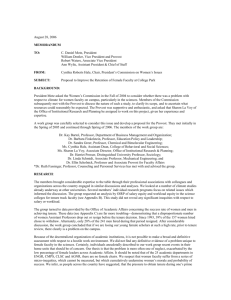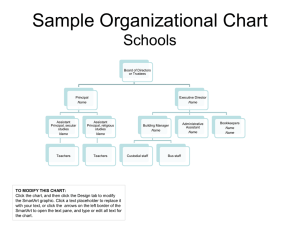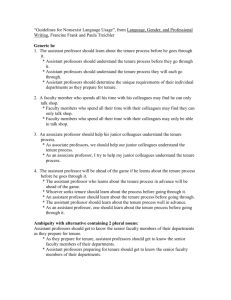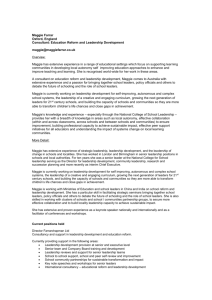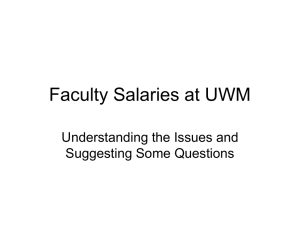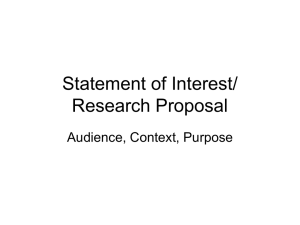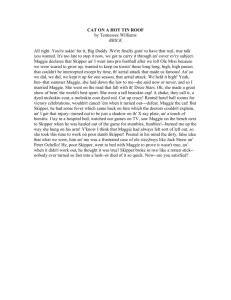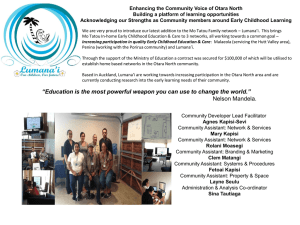PowerPoint Slides
advertisement
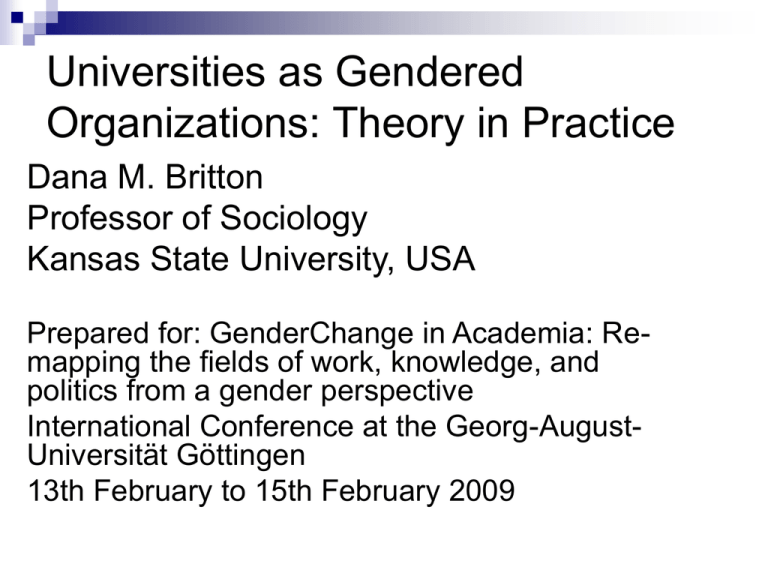
Universities as Gendered Organizations: Theory in Practice Dana M. Britton Professor of Sociology Kansas State University, USA Prepared for: GenderChange in Academia: Remapping the fields of work, knowledge, and politics from a gender perspective International Conference at the Georg-AugustUniversität Göttingen 13th February to 15th February 2009 Funding note: The research presented in this paper is funded a National Science Foundation Award: ADVANCE Partnerships for Adaptation, Implementation, and Dissemination (PAID) Award: PROMOTE Improving the promotion to full processes at western public universities, Principal investigators Kimberly A. Sullivan, Ann Austin, Beth A. Montelone, Dana M. Britton, Tracy M. Sterling. NSF Award #: HRD-0820273 The views presented here are those of the investigator alone Gendering the academy Background and context Gendering through policy – tenure and promotion documents Policy in practice – interviews Reflections on a theory of gendered organizations Table 1. Percent women in each discipline, “top 50” programs Discipline Mechanical Engineering Electrical Engineering Physics Astronomy Computer Science Civil Engineering Chemical Engineering Economics Math Political Science Chemistry Biological Sciences Sociology Psychology % % Women % Women Women Assistant Associate Ph.D.'s Profs. Profs. 10.4 15.7 8.9 Gap between % Gap between Ph.D.'s and % % Ph.D.'s and % Women Assistant % Full Full Profs. Professors Professors 3.2 -5.3 7.2 11.5 10.9 9.8 3.8 0.6 7.7 13.3 20.6 20.5 11.2 20.2 10.8 9.4 15.7 14.4 5.2 9.8 8.3 2.1 0.4 9.7 8.1 10.8 12.2 18.7 22.3 11.5 3.5 -3.6 15.2 22.3 21.4 19.2 4.4 0.9 17.9 29.3 27.2 36.6 19 19.6 36.5 16.3 13.2 28.6 7.2 4.6 13.9 10.3 7.6 0.1 22.1 22.6 22.7 31.3 44.7 21.5 30.4 20.5 24.7 7.6 14.7 9.8 14.3 23.7 30.0 58.9 66.1 52.3 45.4 42.7 40.1 24.3 26.7 6.6 20.7 34.6 39.4 Three possible barriers Organizational demography Tenure and promotion policies Documents in use Kansas State University Data, 2008 Total Men Women % women at Salary ratio rank W/M Salary N Salary N Salary N Full Professor $92,545 408 $94,001 359 $81,877 49 12.0% $ 0.87 Associate Professor $70,456 319 $72,245 217 $66,648 102 32.0% $ 0.92 Assistant Professor $58,521 354 $59,023 215 $57,745 139 39.3% $ 0.98 Instructor $42,769 183 $45,810 74 $40,705 109 59.6% $ 0.89 Average Salary/Total N $70,235 $75,727 865 $58,329 399 31.6% $ 0.77 % of category who are full 1,264 32% 42% 12% Tenure and promotion documents Omission or obfuscation For promotion to full professor: Distinguished reputation in geology, such that he or she would be invited to join our faculty at the rank of Full Professor (Department of Geology Document, 1993). Requirements deliberately unclear No exact quotas or guidelines can exist and a combination of objective and subjective elements will enter into a final decision in the evaluation process. Decisions on acceptable performance levels must contain the individual judgments of the faculty and the administrators involved in the decision (Biological and Agricultural Engineering, 2003). Standards for full professor Promotion to Professor is based on attainment of sustained excellence in the assigned responsibilities of the faculty member and recognition of excellence by all appropriate constituencies (Animal Sciences and Industry, 2007). Most common = National and International reputation Expectations for promotion from associate professor to professor are considerably higher [than those for tenure], including leadership in scholarly research and/or instructional activities, and strong professional recognition at the national and international levels (Biology, 2006) Appointment as Professor is based on the candidate's national and/or international recognition for a distinguished career . . . Such criteria must be fulfilled to high orders of expectations. (College of Veterinary Medicine, Diagnostic Medicine and Pathology, 1998). Policy in practice - interviews Two women full professors, both promoted within the usual six year time span. Both are in science disciplines, one related to biology, another in agriculture. Both are married to men, and both are mothers. Maggie – an agriculture related discipline, mother of a 15 year old daughter born when she was an assistant professor Susan – a biology related discipline, mother of a three year old daughter, born the year she became a full professor. Representation and the pipeline Once the women get into the system, in tenure track positions, I’m not inclined to argue in [my field] that they’re stalled so much by professional limitations, by department limitations. It’s come a long way. I wonder if it’s to some degree a time thing. Like we just have to now get people in the assistant professor positions, which we’re doing, and then get them through the ranks. Which is going to take decades (Susan, full professor, Biology). Representation and the pipeline So if you have 50/50 male and female grad students, you certainly don’t have that mix in terms of faculty. Well, I think what has happened, when I was in graduate school there weren’t many women in [my field]. So I think the population is slowly increasing. Equine is all women – that’s often female-dominated. You know, girls and their horses. So what’s your sense of why, when you look at the proportion of women as PhD’s, and as assistant professors….? The numbers are increasing. It’s in the pipeline. (Maggie, full professor, Agriculture). Standards for promotion to full So what does it take to be promoted to full? Sustained productivity, but there's another dimension to it. The department head who hired me said something that stuck with me: he said that being tenured is an indication that the faculty believe that you have promise, being promoted to Full professor is an indication that you have achieved that promise. And so, what is promise? I think it's a national and international reputation (Susan, full professor, Biology). Maggie’s experience – no policy support When I came here I was the third female faculty member ever in the department. Third in that group, and the first to ever have a child while a faculty member. And that was interesting. How did that work for you? Let’s just say that I am a strong promoter of maternity leave policies for female faculty. Because you didn’t have access to anything, right? No. Nothing. I went right through. I worked until the day or two before she was born. Because being a new faculty member here, I had only been here two years when she was born and I had tried to save as much vacation as I could to be able to have time, and I took four weeks of vacation after she was born. And then she went into child care. That was hard. (Maggie, full professor, Agriculture). Susan – “luck” with policy Well, I think it is harder for women when you factor in the family stuff. That’s real. From a person who’s lived it. Like how do you maintain your research productivity, keep your graduate students on task and all of that when you’re dealing with, you know, a one month old? [Laughs]. That’s really hard. For female faculty who choose to do the family thing, I don’t think, without those instances [of institutional resources], my career would have stumbled. And I can definitely see that when there’s children stuff happening at the assistant professor level, or when you’re associate and there’s that focus for a while, it really slows progress on the research for sure (Susan, full professor, Biology). For both, blocked opportunities Quite frankly, I’ve seen opportunities for getting more administrative skills, and I have just let them go by the wayside, and that was my choice because of my daughter. I was on two boards of directors for [professional organizations], I was on the committee for the National Academy of Sciences. So, I mean I was doing a lot of good things. And then I had a daughter who said, “Mom, you’re gone all the time. Can you stay home more?” And I said “OK, I’ll stay home more” (crying, now pushing back from desk) . . . For both, blocked opportunities Well where do you see yourself, then, ten years down the road, as she’s grown? Probably picking some of that up again as I can. And I, you know, I really enjoyed doing that stuff (eyes are teary all through this). But, there’s times I think administration would be good, but then from a personal side, when I look at the hours involved, evenings and weekends, Monica comes first. So, maybe once she’s out of college. But then again, OK it’s like you put more on this track, and you voluntarily took yourself out of it. Are you ever going to get the opportunity to go back? (Maggie, full professor, Agriculture). National and international reputation I’d love to [go to more meetings and conferences.] I’d love to. But until Monica’s out of high school, I can’t. There’s one that I was going to go to last April, and in another one last year in Pennsylvania. Canceled, I couldn’t go. You know, I couldn’t do the research you’re doing. Because of the travel. I’ve just been declining things left and right (Maggie, full professor, Agriculture). Implications Would more transparency help? Is more bureaucracy better than less for women faculty? The gender framing perspective suggests that whether formal personnel procedures do more good than bad depends not only on the extent to which bias is built into the procedures but also on how powerfully disadvantaging the gender frame would be for women if actors were not constrained by formal procedures. Thus, there is no simple answer to the “are formal rules best” question. But a consideration of the joint effects of the gender frame and the organizational frame allows us to specify how the answer to this question varies systematically with the nature of the context (Ridgeway 2008). In a context in which the gender frame is more salient – e.g., one in which women have no access to policies that help them balance work and family - transparency matters, and can play a key role in inhibiting bias In others the evidence is less clear
